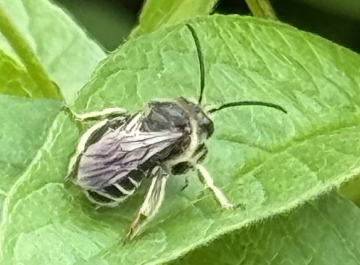Species Account for Macropis europaea
Macropis europaea Warncke, 1973
a mining bee
Aculeata: Melittinae

Reproduction for study and non-profit use permitted, all other rights reserved.
Taxonomic group: bees and wasps (Aculeata) - County data
View time series maps for Macropis europaea
member log-on for taxon report
Status: Na
Essex RDB: Listed
Threat: Essex Vulnerable
Images
upload a new image
Essex Red Data List comment
forages at Lysimachia vulgaris
Species text
The bee is exceedingly localised within its range, but not quite as rare as previously thought. In Falk (1991) there were post-1970 records known for about twenty-five sites. However, the loss and deterioration of wetlands and unimproved water-courses has probably been accompanied by a net loss of populations. The Walthamstow population is only the one of two known in Essex. The species is closely associated with stands of yellow loosestrife Lysimachia vulgaris, especially in fens, but also beside rivers, canals, lakes and bogs or other wet areas on heaths. Higher ground above the summer water table will probably prove to be essential for nesting. Nests are excavated in banks and slopes, their entrances are sometimes concealed below overhanging vegetation. Few British nests have been encountered. The flight period is synchronised with the flowering of yellow loosestrife, from which it obtains both pollen and floral oils (the latter for nest cell lining). Management should maintain reasonably high water levels at wetland sites, in water bodies and water courses, to encourage a rich wetland flora with plenty of Lysimachia. Ensure the presence of slopes, banks or hillocks that provide relatively dry earth, reasonably well above the summer water table, for nesting. Prolonged flooding of likely nesting areas should be opposed and an attempt should be made to ensure that some areas are never flooded. References
Habitats
Recorded management for locations with Macropis europaea
Recorded substrate and hydrology for locations with Macropis europaea
Why not join the Club, register and add a new species page
Interpretation of distribution maps

























